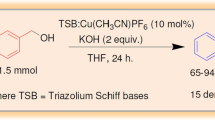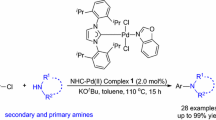Abstract
Cu2O/2,6-bis(2-methylhydrazine-1-carbonyl)pyridine 1-oxide was found to be an efficiently catalytic system for the N-arylation of imidazole, indole, benzimidazole, pyrrole, benzylamine and ethanolamine with aryl iodides and bromides by using NaOH as base in the presence of 20 mol% (n-Bu)4NBr, and water as solvent at 130 °C in 24 h, and giving the N-arylated products in moderate to excellent yields.
Graphical Abstract

Similar content being viewed by others
Explore related subjects
Discover the latest articles, news and stories from top researchers in related subjects.Avoid common mistakes on your manuscript.
1 Introduction
The works of copper-catalyzed formation of C–N bond have made great progress after the pioneering works of Ullmann and Goldberg and have become one of the most powerful integrated strategies for building nitrogen-containing intermediates, which exist in natural products, pharmaceuticals and pesticides [1, 2]. However, several drawbacks of Ullmann-type coupling reactions, including stoichiometric amounts of copper reagents, high reaction temperature, extended reaction time and narrow functional-group tolerance, limited its applications. Over the past decade, significant improvements have been achieved to improve its efficiency and selectivity by using various ligands, such as 1,2-diamines, amino acid, diols, imines, ß-diketones and others [3,4,5,6,7]. While significant progress has been made in the transformation described above, it is still highly desirable to develop an easily accessible, economical and environmentally friendly solution for this type of reactions.
In spite of advances of organic transformations using organic solvents, its drawbacks can’t be ignored, including healthy problems, violating the principle of environmental friendliness. In terms of the requirements of green chemistry, various environmentally benign reaction media have been used as substitutes such as water, supercritical fluids and ionic liquids [8]. Obviously, water is the most attractive one because of its inimitable characters of nontoxic, cheap, and readily available [9, 10]. Therefore, during recent years, water has been successfully employed as a highly desirable solvents for organic transformations [10,11,12,13,14], of which copper-based amination of aryl halides in aqueous media or even in pure water has also been established [8, 15,16,17,18,19,20,21,22,23,24].
Previously, we have designed and synthesized a novel series of 2-(hydrazinecarbonyl)pyridine N-oxides [25, 26] and its structural analogues [27] as ligands for copper-catalyzed N-arylation of nitrogen nucleophiles in water (Scheme 1). The results indicated that the N-oxide/anionic phenolate and acylhydrazine moieties of the ligands were the active sites, which might coordinate with the copper ion as the catalytic center in these catalytic systems. However, because of the relatively narrow substrate scopes of these examples mentioned above, we therefore set out to look for an improved catalyst system for this transformation. Herein, we optimized and designed 2,6-bis(2-methylhydrazine-1-carbonyl)pyridine 1-oxides as the ligands for C–N coupling reaction in water.
2 Results and Discussion
To evaluate the catalytic efficiency of the catalyst, imidazole and iodobenzene were chosen as model substrates for the coupling reaction in water. The standardized protocol was carried out by using imidazole (1.5 equiv.), iodobenzene (1 equiv.), base (2 equiv.), Cu source (10 mol%), and ligand (20 mol%) in water at 120 °C for 12 h. The results are shown in Table 1.

Between the two ligands used, L1 exhibited much higher catalytic ability than L0 (entries 1 and 2). As the better ligand was determined, we next examined copper sources, and CuCl, Cu2O, CuO combined with L1 afforded the N-arylated product in good yields of 70, 75, and 73% respectively (entries 4, 5, and 7). Control experiment certificated that copper catalyst of the reaction mixture was essential (entry 9). The following screening of various bases, including NaOH, KOH, K2CO3, K3PO4 and Cs2CO3, indicated that NaOH to be the best one in 75% yield (entries 5 and 10–13). Furthermore, temperatures lower than 120 °C resulted in inferior product yield while dramatically increased the yield when temperatures higher than 130 °C and prolong the reaction time to 24 h (entries 14–16). Decreasing the loading of ligand resulted in lower yields (entry 17). In summary, the optimal conditions for the N-arylation process in water consist of the combination of Cu2O (10 mol%), NaOH (2 equiv.), L1 (20 mol%), TBAB (20 mol%) at 130 °C for 24 h without the protection of inert gas.
In order to explore the scope of the application of the catalytic system, a variety of functionalized aryl iodides and bromides were aminated with nitrogen nucleophiles in water under the optimized reaction conditions, and the results were demonstrated in Tables 2 and 3. As shown in Table 2, to our delight, most of the nitrogen-containing heterocycle and amines with aryl iodides reacted well to afford the corresponding products in moderate to excellent yields (38–95%). Electron-donating groups seemed to be more beneficial than electron-withdrawing groups for these catalytic system. No obvious electronic effects were observed for para- and meta-substituted aryl iodides, however, steric hindrance of ortho-substituents resulted in a lower reactivity and afforded lower yield (entry 4). The amination of heteroaryl iodides, including dibenzothiophene (entry 10) and quinoline (entries 11, 14 and 17), proved to be successful. Notably, the coupling of aryl iodides with other N-containing nucleophiles, such as indole, benzimidazole, pyrrole, and benzylamine, did occur smoothly (entries 12–18). Interestingly, the reaction was highly chemoselective; for example, reaction of ethanolamine only gave the N-arylated product under present conditions (entry 19). As a result of lower activity of aryl bromides than that of iodides, the coupling reaction of aryl bromides provided slightly lower yields (Table 3, entries 1–5), and fortunately, heteroaryl bromides also coupled with imidazole to give the corresponding products in moderate yields (Table 3, entries 6–8).

A large scale synthesis was performed by taking 5 mmol of iodobenzene and 7.5 mmol of imidazole in 10 mL of H2O at 130 °C for 24 h, and the reaction proceeded without any difficulty to obtain N-aryl product 3a in 89% yield (Scheme 2).
A proposed mechanism for the present coupling reaction is shown in Scheme 3. In the presence of NaOH, Cu2O might react with L1 to afford Cu(I) complex I, in which the strong electron-donating ability of the ligand could make this complex very active toward the oxidative addition with an aryl halide. The oxidation addition of I with aryl halides provided Cu(III) complex II, which might interacts with nitrogenous heterocycle to form III. Reductive elimination of III led to the coupling products and regenerated the catalytic species I.
3 Conclusions
In summary, this effort has led to the identification of 2,6-bis(2-methylhydrazine-1-carbonyl)pyridine 1-oxide as an ideal ligand for promoting copper-catalyzed Ullmann-type coupling reactions of aryl halides with nitrogen nucleophiles in water. The protocol demonstrated broad substrate scopes with good isolated yields. Further studies of this catalytic process are currently underway in our lab, and will be reported in due course.
3.1 Experimental Section
3.1.1 General Methods
Unless otherwise stated, all reagents were purchased from commercial suppliers and used without further purification. Column chromatography was performed with silica gel (200–300 mesh) purchased from Qingdao Haiyang Chemical Co. Ltd. Thin-layer chromatography was carried out with Merck silica gel GF254 plates and visualized by exposure to UV light (254 nm). All derivatives are characterized by 1H NMR and 13C NMR and GC-MS, which were compared with the previously reported data. 1H NMR spectra and 13C NMR spectra were recorded at room temperature on a Bruker Avance III HD 400 instrument at 400 and 100 MHz, respectively. Mass spectra were recorded on GC-MS (Agilent 7890A/5975C) instrument under EI model. Electrospray ionization high-resolution mass spectra (ESI–HRMS) were recorded on a Thermo Scientific LTQ Orbitrap XL high-resolution mass spectrometer.
3.1.2 General Procedure for the Synthesis of 3a–3w
A 25 mL Schlenk tube was charged with Cu2O (0.05 mmol), ArX (0.5 mmol), NHR1R2 (0.75 mmol), NaOH (1 mmol), TBAB (0.1 mmol), L1 (0.1 mmol) and water (1 mL). The mixture was stirred at 130 °C for 24 h. The reaction mixture was extracted with ethyl acetate (3 × 10 mL), washed with water and brine, dried over anhydrous Na2SO4, and concentrated in vacuo. The residue was purified by flash column chromatograph on silica gel (ethyl acetate/petroleum ether as the eluent) to provide the target products 3a–3w.
References
Zhou W, Fan MY, Yin JL, Jiang YW, Ma DW (2015) J Am Chem Soc 137:11942
Hagberg DP, Yum JH, Lee HJ, Angelis FD, Marinado T, Karlsson KM, Humphry-Baker R, Sun LC, Hagfeldt A, Gratzel M, Nazeeruddin MK (2008)J Am Chem Soc 130:6259
Sambiagio C, Marsden SP, Blacker AJ, McGowan PC (2014) Chem Soc Rev 43:3525–3550
Monnier F, Taillefer M (2009) Angew Chem Int Ed 48:6954–6971
Ma DW, Cai Q (2008) Acc Chem Res 41:1450–1460
Beletskaya IP, Cheprakov AV (2004) Coord Chem Rev 248:2337–2364
Ley SV, Thomas AW (2003) Angew Chem Int Ed 42:5400–5449
Carril M, SanMartin R, Dominguez E (2008) Chem Soc Rev 37:639–647
Narayan S, Muldoon J, Finn MG, Fokin VV, Kolb HC, Sharpless KB (2005) Angew Chem Int Ed 44:3275–3279
Li CJ (2005) Chem Rev 105:3095–3166
Dallinger D, Kappe CO (2007) Chem Rev 107:2563–2591
Lindström UM (2002) Chem Rev 102:2751–2772
Li CJ, Chen L (2006) Chem Soc Rev 35:68–82
Herrerías CI, Yao XQ, Li ZP, Li CJ (2007) Chem Rev 107:2546–2562
Wang Y, Wu ZQ, Wang LX, Li ZK, Zhou XG (2009) Chem Eur J 15:8971–8974
Liang L, Li ZK, Zhou XG (2009) Org Lett 11:3294–3297
Guo ZN, Guo JY, Song Y, Wang LM, Zou G (2009) Appl Organometal Chem 23:150–153
Xia N, Taillefer M (2009) Angew Chem Int Ed 48:337–339
Wang DP, Cai Q, Ding K (2009) Adv Synth Catal 351:1722–1726
Xu HH, Wolf C (2009) Chem Commun 2009:3035–3037
Jiang LQ, Lu X, Zhang H, Jiang YH, Ma DW (2009) J Org Chem 74:4542–4546
Wu ZQ, Jiang ZQ, Wu D, Xiang HF, Zhou XG (2010) Eur J Org Chem 2010:1854–1857
Xie JW, Zhu XH, Huang MN, Meng F, Chem WW, Wan YQ (2010) Eur J Org Chem 2010:3219–3223
Engel-Andreasen J, Shimpukada B, Ulven T (2013) Green Chem 15:336–340
Wu FT, Yan NN, Liu P, Xie JW, Liu Y, Dai B (2014) Tetrahedron Lett 55:3249–3251
Wang XC, Zhang J, Xie JW (2017) Chem J Chin Univ 38:1178–1184 (in Chinese)
Yan NN, Wu FT, Zhang J, Wei QB, Liu P, Xie JW, Dai B (2014) Asian J Org Chem 3:1159–1162
Acknowledgements
We gratefully acknowledge the Natural Science Foundation of China (21606153) for the financial support.
Author information
Authors and Affiliations
Corresponding author
Electronic supplementary material
Below is the link to the electronic supplementary material.
Rights and permissions
About this article
Cite this article
Wang, X., Meng, F., Zhang, J. et al. 2,6-Bis(2-methylhydrazine-1-carbonyl)pyridine 1-oxide as an Efficient Ligand for Copper-Catalyzed C–N Coupling Reaction in Water. Catal Lett 148, 1142–1149 (2018). https://doi.org/10.1007/s10562-018-2321-8
Received:
Accepted:
Published:
Issue Date:
DOI: https://doi.org/10.1007/s10562-018-2321-8







